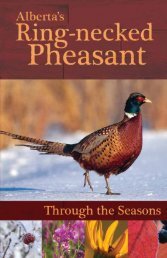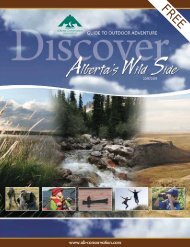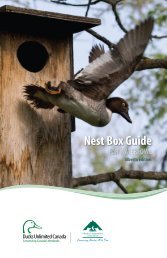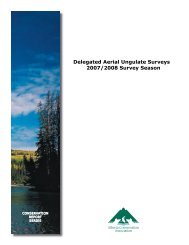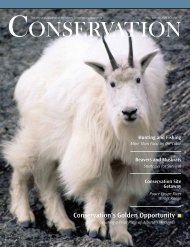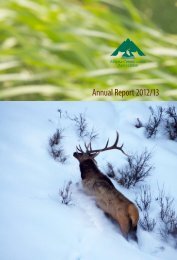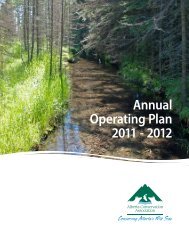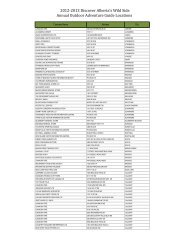Download Magazine PDF - Alberta Conservation Association
Download Magazine PDF - Alberta Conservation Association
Download Magazine PDF - Alberta Conservation Association
You also want an ePaper? Increase the reach of your titles
YUMPU automatically turns print PDFs into web optimized ePapers that Google loves.
We manage aherd of 300wood bison onland reclaimedfrom our miningoperation.We areresponsiblefor 70% of thereclaimed landin the oil sandsmining industry.HAVE YOU HEARD?The wood bison that live on our reclaimedland are a testament to our commitmentto nature. Returning the land is not aresponsibility we take lightly; to date,we have planted over 5.8 million treesand reclaimed over 3,500 hectares.Innovation in all areas of oil sandsdevelopment —that’s why we have beenindustry leaders from the beginning.syncrude.caThe Syncrude Project is a joint venture undertaking among Canadian Oil Sands Partnership #1, Imperial Oil Resources, Mocal Energy Limited, Murphy Oil Company Ltd.,Nexen Oil Sands Partnership, Sinopec Oil Sands Partnership, and Suncor Energy Oil and Gas Partnership.Hop, Skip and a Jump<strong>Conservation</strong> Site GetawaysThe Wild TableJerky<strong>Conservation</strong> WorksPutting out the Welcome Mat12Meet the LandownerGlen and Kelly Hall of Timber Ridge16Cover Photo: Brad Downey, ACAAcre by AcreThe Art of Land Management8Pull out Section for Kids!1014The Balog RanchA Fresh Take on ManagingLivestock for Threatened Species 18More thanFluffThe Curious Behavioursof Rabbits and Hares2026Going UnnoticedThe Fate of 5 Common BirdsCelebrating 15 yearsACA by the Numbers30Behind theScenesLake Aeration231997-2012CONSERVATION MAGAZINE SPRING/SUMMER 2012www.ab-conservation.comOur MissionACA conserves, protects and enhances fish, wildlifeand habitat for all <strong>Alberta</strong>ns to enjoy, value and use.Battery MedicBell SolutionsBow Valley PowerCabela’s CanadaCanadian <strong>Association</strong>of PetroleumProducersCanadian NaturalResources Ltd.Canadian WesternBankCTV Television Inc.Cycle WorksMotorsportsDaishowa MarubeniInternationalDevon CanadaCorporationDOW ChemicalCanadaJobsite WorkwearLa Terra VenturesLet’s Go OutdoorsPacrim HospitalityPenn West PetroleumShell Canada EnergySherwood ParkToyotaSign-A-RamaSuncor EnergyFoundationSyncrude Canada Ltd.Windshield SurgeonsRead more about our corporate partners atab-conservation.com/cpic.To become a Corporate Partner in <strong>Conservation</strong>,contact Cindi Webster at 780-410-1983.Contact us to receive your FREE biannualsubscription to <strong>Conservation</strong> <strong>Magazine</strong>:E-mail info@ab-conservation.com with“E-mail Subscription” in the subject line.<strong>Download</strong> electronic copies online atab-conservation.com.Phone: 780-410-1999 or call toll free:1-877-969-9091.Moving? Change of address? Stay in touch.Be sure to contact us and keep your subscriptionup to date. Returned issues marked "undeliverableaddress" are deleted from our database!PUBLICATIONS MAIL AGREEMENT NO.41260556RETURN UNDELIVERABLE CANADIAN ADDRESSES TO101-9 Chippewa Road, Sherwood Park, <strong>Alberta</strong> T8A 6J73
Conserving Land forgenerations to Come242 mphdon’tblink.The Shell True North Forest is part of our ongoing efforts toaddress the footprint of our oil sands operations. This naturalenvironment in Northwest <strong>Alberta</strong> is an important habitat andmigratory route for wildlife in the area. Through initiatives likethe Shell True North Forest, we are protecting natural areas forCanadians to enjoy well into the future, now.www.shell.ca/truenorthforestStreaming live 24/7 at ab-conservation.com/peregrinecamThe 2012 Peregrine Cams were provided by United Protection Services and are powered by Bell Solutions.Peregrine falcons are the fastest living thing onearth. And each year they fly back to Edmonton,travelling up to 11,000 km from South America insearch of a mate.You can try to catch a glimpse—but whynot watch Edmonton’s peregrines up closeand personal? Two cameras, two families andcountless unpredictable moments.
The wild table from field to forkJerkPeople like it. Period.Like bacon, there aren’t many meateating folks who don’t dig jerky.My two year old?Keep it foreverenviro-foodIt’s actually a terribly underrated food, as itallows for food preservation without usingenergy to keep it safe to eat.That’s right, no refrigerationnecessary. If my freezer wereto pack it in without meknowing, my frozen meat istoast. Not my jerky. Left itout on the counter for threemonths? No problem.Put it to gooduseI hunt big game. If you hunt afair bit and have some successat it, there are times whereyou’re looking for ideas ofwhat to do with that roundroast or sirloin tip. Jerky isyour solution. This spring and summer, you’ll(hopefully) be using up the rest of last fall’sgame. Make lots, and you’ll be glad you didwhen it’s time to pack food for your nexthunting trip. Jerky makes choice field-food.the recipeHates meat. Loves jerky.• by Kevin KossowanHow to make it?Forget buying the stuff. Look at thosepackages and keep in mind jerky should bemeat, salt, and some aromatics to make ittasty. Dismayed by the ingredient list? Me too.Make it yourself. It’s easy.You can make jerky out ofany piece of meat, but it’sfar easier if you start with abig cut. A favourite is roundof moose or elk, as it’s agood size, and because theslices are big they’re easierto manage in the dryingprocess. Remember thatyou’re eating uncooked meat,so make sure your meat isgood quality—save the packof freezer-burned ruttingbuck for something else (notsure what).Drying meat is not rocket science, butrequires some ingenuity, which makes it fun.You can hang strips over a smouldering fire.I put the strips of meat on baking racks overa wood fire that’s cool enough not to cookthe meat, but just warm enough to generatesome smoke. Most folks will use an oven onits lowest setting with the door slightly ajar.Whatever method you use, keep in mind thatwe’re not cooking it, just drying it.SaskatoonsGive it a shotWhile out snacking on your homemade jerky,take a look to see if the saskatoons are ready.The verdict on the saskatoon’s culinary valuedepends on who you ask. It seems to be a bitof a love-hate fruit, and I’ll happily acceptthe task of trying to encourage the haters tochange camps.I think I’ve put my finger on what peopledon’t like; it has a seedy and robust texturecompared to the blueberry folks are used to.But in exchange, the saskatoon delivers bigin both the yield and flavour departments,with a unique almond extract tone. Haven’tseen any stats on it, but I’d guess you’re lesslikely to be eaten by bears while pickingsaskatoons—always a bonus.Anything goesWhat to do with them? My kids eat themfrozen. They’re good in most bakingapplications…saskatoon pancakes are lovely.Make syrup for flavouring yogurt or ice cream.Jam. If you have loads, make wine. They pairfantastically with game meats. If you needguidance on that front, you can find more onmy website at www.kevinkossowan.com. nphotos: istockphotoper pound of meat1 tbsp kosher salt1 tbsp soy sauce2 tsp dark brown sugar2 cloves garlic, minced1 tsp cracked black pepper1 tsp dried chili [optional]Slice meat thin and most importantly—evenly—while stillpartially frozen. Mix with marinade ingredients above,and refrigerate for a day to three. Dry via your method ofchoice. Note that jerky pieces never finish all at the sametime, so you have to pull them off as they get to a textureyou like.Note: Goose, turkey and pheasant make good jerky as well.Kevin Kossowan is a local food writer deeplyCONSERVATION MAGAZINE SPRING/SUMMER 2012involved in <strong>Alberta</strong>’s urban agriculture and foragingcommunities. He believes wild foods are critical toour regional food culture. Join us every issue as hecelebrates and advocates <strong>Alberta</strong>’s regional foods withtips, recipes and fresh ideas.WILD ON THE WEBab-conservation.com/mag/easypicksDiscover more berry picking locations, tips and recipes.11
CONSERVATIONWORKSPutting out the Welcome Mat• by Ariana Tourneur, ACA Picky, pickyHave you ever teared up during a oneof those home makeover shows? Youknow the one—a family faces seeminglyinsurmountable circumstances while livingin a decrepit house literally splitting at theseams. But we smile as an army of talenteddo-gooders sweeps in, works some magic,and completely rebuilds the house intosomething many of us couldn’t even dreamup. We like to think we do it too—for wildlife!photos: Randy Lee, ACAAdmittedly, our work isn’t nearly asenchanting or glamorous. And unlike theshow, creating the perfect home for wildlifetakes longer than a week, typically closer toa decade! That’s because many species canhave very particular habitat requirements(discerning taste like us!). Home sweethome often involves standing grass, shrubbythickets, dense patches of trees, graincrops, weedy areas, wetland margins andshelterbelts, all in close proximity.The tough lifeThese demands are all for good reason: justlike us, animals battle the brutal <strong>Alberta</strong>winters. Freezing temperatures, arctic winds,snow, ice-covered ground and a lack of foodmake this a risky season. Dense vegetationcover is essential in providing warmth. Whilewe pile on sweaters, toques, mittens andscarves, each vegetation layer acts as theirextra insulation. It’s also a perfect hidingplace or escape route from hungry predatorssuch as coyotes.Acres of potentialIt’s no easy feat to find suitable habitat forwildlife to flourish. That’s why we wereecstatic to partner on two properties fullof possibility. About one hour northeast ofLethbridge, near the Hamlet of Hays, arethe 140-acre East Hays and 100-acre Legacy<strong>Conservation</strong> Sites. They’re lovely, tranquilspots, overlooking the grassy coulees of theBow River.An open-air renovationThe East Hays <strong>Conservation</strong> Site, purchasedin 2008, was used as irrigated hay landand possessed incredible potential for thedevelopment of important wildlife habitat.We quickly set to work and with our partners,created an enhancement and managementplan for the property. Now the site is in themidst of its makeover, providing year roundcover types, particularly for upland gamebirds.After a thorough look at the property andsurrounding area, the winter cover obviouslydidn’t measure up—so it became first on theto-do list. In 2009, we planted 13 acres ofshelterbelts (29 rows and 11,000 shrubs)...a1. Dyke construction completed at East Hays<strong>Conservation</strong> Site, July 2009.2. Filling wetland via Bow River Irrigation Districtsupply canal and turnout, August 2009.3. Wetland vegetation growth one year later, August 2010.4. Wetland progression, August 2011little more than standard curb-appeal! Wechose a variety of shrub species for theirhardiness and habitat values, includingsnowberry, hedge rose, caragana, buffaloberry and lilac.Next up was the construction of two wetlandsthat would fill about five football fields. Theywill be managed as cattail marshes to offeradditional winter cover, particularly for ringneckedpheasants. We had to think aboutother life stage components too. Managementof the remaining hay land will help enhancereproductive cover (for nesting and broodrearing) and escape cover (which includestravel lanes and connectivity).Welcome the newneighboursThe Legacy <strong>Conservation</strong> Site, purchased in2010, was also previously used as irrigatedhay land. Approximately 35 acres of old hayland was reseeded to a grass/forb mix—perfect nesting and brood rearing cover.Constructed in 2011, a 12-acre, five cellwetland complex is a unique addition andprovides essential winter cover as the cattailsfill in. Future enhancements may includeshrub plantings as wildlife corridors and foodplots to help birds overwinter. Remember,always try and put the kitchen next to thebedroom! nEasy Hays partners: <strong>Alberta</strong> <strong>Conservation</strong><strong>Association</strong>, <strong>Alberta</strong> Fish and Game<strong>Association</strong>, Bow River Irrigation District,Brooks Fish and Game Club/Brooks PheasantFestival, CALFRAC Well Services Ltd,Habitat Legacy Partnership, MD of Taber,Pheasants Forever Chapters (Calgary &Chinook) and other private contributors.Legacy partners: <strong>Alberta</strong> <strong>Conservation</strong><strong>Association</strong>, David Bissett and PheasantsForever-Calgary ChapterWhat can you do?Gimme shelter. Winter can be a challengingtime for wildlife, especially where agriculturalcrops are important. Next time you’re in thefield, look around and ask yourself, “Is thereany thick brushy cover or cattail complex withina mile?” If not, see if there are any places toput some, such as pivot corners, idle areas ormarginal lands.Make a tweak. A full-on redo isn’t the onlyoption when it comes to enhancing habitat. Infact, minor adjustments to your current practicescan substantially help. The types of crops and therotation you use can provide benefits to wildlife,delaying haying until after July 15th can improvenesting success, and leaving grassy buffer stripsaround field margins can add wildlife value.These are just a few of the many tweaks that canmake all the difference.Bring it all back. Consider taking the plungeand restoring your range to native vegetation orother permanent cover. It’s a bigger undertaking,but one you won’t regret. And neither will thethousands of species you help.Find out more about enhancing yourland for wildlife by contactingLayne Seward, ACA at 403-388-7764.With support, planning and plain hard work, the East Hays and Legacy<strong>Conservation</strong> Sites are transforming into a wildlife haven.WILD ON THE WEBab-conservation.com/guide<strong>Download</strong> driving directions to East Hays and Legacy<strong>Conservation</strong> Sites and take a look at our renovations.CONSERVATION MAGAZINE SPRING/SUMMER 201213
Meet theLandownerGlen and Kelly Hall of Timber Ridgephoto: Michael Short• by Elize Smit, ACAImagine going for a walk andseeing moose, elk, mule deer,a black bear, a blue-wingedteal brood, mallard ducks andwaxwings—all in an hour or two.There are waving grasslands, trees,creeks, springs, and rolling hills. Upahead, a ridgeline. It seems gentlefrom afar but makes you work forits spectacular reward: a beautifulwestern view of the PorcupineHills. Turn around to see a stretchof farmed prairie, and to thenorthwest, the Livingstone Range.Nearby a spring bubbles with waterso pure you can refill your waterbottle. Sound too perfect? It’s not.photo: Brad Taylor, ACAThis experience awaits anyone visitingthe new Timber Ridge <strong>Conservation</strong>Site near Calgary. If you’re lucky,you’ll run into Glen and Kelly Hall, full-timestewards of this amazing place where, as Glensays eloquently, agriculture and conservation“are going down the same track…we’reparallel.”The Halls are ranchers with a mixed farmingoperation. They’re passionate about keepingthe land intact and ranching sustainably.Conserving the native grassland and springson their land is very important. MikeUchikura, biologist with ACA, describesthem as proactive and forward-thinking:“Over the past decade or so they’ve reallyembraced what conservation and stewardshipmean, holding onto their principles ofknowing what they do on their landscapeaffects the larger community.”Kelly cuts to the chase when she says, “Wehave a little piece of heaven out here.” Glenadds, “It’s been a goal of ours ever since webought the land: that we keep it like it is.”Trust in a visionTimber Ridge is the first time ACA haspartnered with private landowners on buyinga site. It requires trust, but after severalmeetings, both ACA and the Halls concludedthat the benefits in this partnership definitelyoutweigh the risks. Under the umbrella ofconservation, Timber Ridge is a wonderfulopportunity to explore how sustainablefarming practices and smart landscapemanagement benefit the community andwildlife. The dream: having school buses fullof kids visit so they can experience natureand see firsthand where their food and watercome from, and what it takes to provide itresponsibly.Water is where it’s atSpeaking of water, the springs on TimberRidge are incredible. Forming part of theheadwaters for Nanton Creek, the springsare vital to many people, including the Townof Nanton. Instead of letting their cattlemuck it up, the Halls installed undergroundpiping that channels the water into developedtroughs. Beyond having an incredible daywalking in breathtaking rangeland anddrinking pure spring water, Timber Ridgecreates an awareness of the care the Halls taketo make things better for everyone. Thosesprings are in great shape because the Hallsrecognize that how they are treated affectseveryone downstream. That’s praiseworthy.Visiting Timber RidgeTimber Ridge is an active farming operation,so you must call ahead to book a time. TheHalls will tell you what to expect and areas toavoid. It also ensures a special experience foryou since only one group per day is allowed.Remember: use respect. Leave the land betterthan you found it. If you open a gate, close itbehind you. Be aware of your surroundings—from grouse to grizzlies, treat wildlife withrespect. Interested? Call 403-646-5813.Timber Ridge is designated as a <strong>Conservation</strong>Site. For more details search Timber Ridge atab-conservation.com/guide. nWILD ON THE WEBab-conservation.com/magHear more about Timber Ridge in our interview withGlen and Kelly Hall.join the wild bunch.Every single gift is a chance—for habitat, for wildlife, forour generations of tomorrow to enjoy a wild and thriving<strong>Alberta</strong>. Explore the many options available and considerhelping us in the way that best suits you. Together we canconserve and enhance the special place we call home.www.ab-conservation.com/give14CONSERVATION MAGAZINE SPRING/SUMMER 2012
Acre by AcreThe Art ofLandManagement• by Elize Smit, ACAFrom <strong>Alberta</strong>’s tangled, lush borealforests down to the sweepingpanoramas of the prairies, wemanage over 200 propertiesspanning more than 200,000 acres. It’s alot of paperwork, a lot of time covering alot of ground, and the part not found inthe job description…a lot of pride. Landmanagement might sound a little dull, but theend result—making a tangible difference on<strong>Alberta</strong>’s landscape—is anything but.Gaining groundWhat does land management actually mean?ACA Land Program Manager Darren Dorgebreaks it down to the basics: “Our jobs areabout securing habitat and then activelymanaging those lands.” On the securementside, our biologists handle land purchasesand donations. A hefty checklist determinesif and where a potential <strong>Conservation</strong> Sitefits. The team considers everything. How doesthe land work with what ACA already has?Does it help conserve a wildlife corridor?How close it is to other <strong>Conservation</strong> Sitesor protected lands like provincial parks?What shape is the habitat in? And what kindof recreational opportunities can it offer<strong>Alberta</strong>ns? Partnerships are very importantat ACA, so we also consider if the landcomplements our corporate partners’ goals,and if there are other conservation groupswilling to collaborate with us.A good neighbourWhen it comes to management, our biologistsare stewards. If you’re a private landowner,you already know the job because you do ittoo—maintaining fences, controlling weeds,working with industry and the like. ACAbiologist Stefanie van Huystee points out,“We want to be good neighbours.” Sincethe infrastructure (mostly roads, parkinglots, garbage bins and outhouses) on severalfisheries access sites (usually lakes) needsmaintaining, the work is sometimes on alarger scale. And again, partnerships comeinto play, this time with landowners. On some<strong>Conservation</strong> Sites, through a bid processwith local ranchers and farmers, we usegrazing as a management tool.Land managers repair degraded habitat byrestoring drained wetlands, replanting nativegrasses and trees, getting rid of invasive weedsand so on. The ultimate reward? Watchingnative plant and animal species return andflourish again. Getting there, however, is oftena years-long process requiring patience andendurance.Sharing an outlookEven though the team is busier than ever,building partnerships is still the heart of it all.Connecting with landowners like Glen andKelly Hall, other conservation organizations,corporate partners and volunteers is the mostimportant thing ACA biologists do every day.They get that managing land is about workingtogether. Real conservation doesn’t happenany other way. nBeaverhill Lake <strong>Conservation</strong> Site.photo: Len Peleshok, ACAWILD ON THE WEBab.conservation.com/landFind out more about our land management work.Why conserve land?photo: Brad Downey, ACAFor most of us, wanting to hang onto the land that enriches our lives is reason enough to support conservation. Butmore than that, conserving our natural areas is essential for all living things. At ACA, each purchase, partnership ordonation of property establishes a network of habitat that wildlife depend on. The ultimate bonus? We get to enjoythese special places for generations to come.16 CONSERVATION MAGAZINE SPRING/SUMMER 2012CONSERVATION MAGAZINE SPRING/SUMMER 201217
Princesses kissing frogs, turning them into handsomeprinces and living happily ever after may abound in fairytales, but real-life frogs in rural <strong>Alberta</strong> need fairy-tale-like salvation, especially the northern leopard frog. Theirnumbers are declining dramatically under increasingthreats to their environment. With only a handful ofknown breeding sites remaining, these frogs need the kindof help that borders on magic.photo: Kris Kendell, ACAFrom their ranch in southern <strong>Alberta</strong>,the Balog family is making this magichappen. Their stewardship efforts havecreated a wonderland of clean water and lush,secure habitat for frogs, enabling them tothrive. Ken, the fourth generation of Balogson the ranch says, “If frogs aren’t thrivingaround the dugout and along the creek it sayssomething about our management. Maybewe have done some things right, becausethe frogs are still here. But can we do thingsbetter?”The Balogs have always taken a keen interestin the wildlife that flies over, walks across orswims through their ranch. Of course theyknew about the frogs, but it wasn’t until a pairof biologists sat down at the kitchen tableand explained the results of an amphibianinventory that it became clear, their frogs wereof the threatened northern leopard variety.THE BALOG RANCHfor rearing young. Clearly then, landmanagement changes would benefit bothfrogs and cows. Without choices for waterand motivation to move, cows linger inriparian areas, affecting both their waterquality and the aquatic habitat frogs need.It came down to planning: to enhancefrog habitat the timing and distribution oflivestock along Red Creek needed to change.Save a frog.Outsmart a cow.Grazing management along riparian areasis about enticing livestock with drinkingoptions away from riparian areas. With<strong>Alberta</strong> <strong>Conservation</strong> <strong>Association</strong> (ACA)and MULTISAR’s * help, the Balogs installedtwo off-stream water troughs to give cowsan alternative to drinking directly from thestream. One system taps water from a dugout;the other is portable and allows livestockpressure points to be minimized along RedCreek.In dry years the watering systems conservewater, a significant benefit to cows and frogsin an arid landscape.The relationship developed between staffof ACA, MULTISAR and the Balogs goesbeyond business. Getting to know one anotherover the years has led to mutual respect,credibility, learning and sharing. The cowsand frogs are happy, and the Balogs nowhave a comprehensive ranch inventory and amanagement plan guiding their sustainableranching effort.Financial assistance through ACA/MULTISAR from Government of CanadaHabitat Stewardship Program and CanadianNatural Resources Limited helped with theoff-stream water developments.*MULTISAR is “Multiple Species at Risk”and has many partners including ACA,<strong>Alberta</strong> Sustainable Resource Developmentand the Prairie <strong>Conservation</strong> Forum whowork to conserve habitat for species at riskin the grasslands of <strong>Alberta</strong> while balancingsustainable ranching needs and goals.Red Creekphoto: Nora Balog• by Lorne Fitchphoto: Brad Downey, ACAA fresh take onmanaging livestock forthreatened species.The Balog Ranch lies in an arid landscape.Riparian areas became the focus for livestockmanagement, providing both sustainablelevels of grazing for the cows and habitatfor the frogs. Based on range inventoriesand a long grazing history, the Balogsreally understood the carrying capacityof their pastures. They also knew that thetheoretical “average” amount of forage maynot be available in dry years, so they adjustthe annual stocking rate to compensatefor rainfall, and rotate cattle through theirpastures to harvest forage and allow grass torecover.This works well when livestock are the onlyspecies dependent on forage; the challengecomes when frogs are added to the equation.Upon listening to the biologists’ ideas, itbecame evident that the solution wouldnot mean losing grazing land, but rathermanaging livestock with the needs of frogsin mind. Frogs, like cows, thrive withclean water, lush vegetation, and securityOff-stream water sources and movingsalt blocks let the Balogs manage cattledistribution to benefit both livestock andfrogs. As Ken and Nora have observed, “givecattle a choice of clean water, they’ll walk amile to the trough.” Other livestock producershave noted better weight gains with cleanwater. And the watering sites mean cattleavoid getting bogged down in the mud,another benefit that pleases the Balogs.More than machinery.In this stewardship fairy tale, the Balogs havefigured out how to live on a piece of land,run a successful agricultural operation, andmaintain a species at risk for the benefit ofall. Besides technical expertise and piecesof equipment, the project’s success requiredcaring, open-mindedness, ecologicalawareness, a strong land ethic and a visionfor the future. There is a harmony and arelationship between humans and wildlifeon the Balog Ranch that is inspirational,proving there can be a “happily ever after” foreveryone—even a frog.WILD ON THE WEBab-conservation.com/magExplore more ways to encourage amphibians onyour land.Solar powered off-streamwater trough.photo: Brad Downey, ACACows choose clean water from the trough,rather than going to the stream.photo: Nora Balog18 CONSERVATION MAGAZINE SPRING/SUMMER 2012CONSERVATION MAGAZINE SPRING/SUMMER 201219
FluffThe curious behaviours of rabbits and hares• photos and text by Wayne LynchItwas the last day of May ona perfect prairie afternoon,south of Patricia, <strong>Alberta</strong>.Powdery clouds drifted overhead anda light wind carried the rich scent ofpasture sage and fresh grass.A northern harrier hawk was tackingback and forth along a narrow stripof prairie, diving over a white-tailedjackrabbit. Each time it swooped low,the jackrabbit rushed at it and evenleaped upwards, as if to swat the hawk,but didn’t make contact. The predatoryharrier, normally a vole specialist, wasno match for the muscle and bulk of thejackrabbit that probably weighed tentimes as much.Curious to find out what was happening,I walked towards the jackrabbit, who fledat my approach. In a slight depression inthe grass huddled three baby hares. Freshblood speckled a few blades of grass atthe edge of the nest, but none of the hareshad visible injuries. Perhaps the harrierhad already snatched a young one andwas returning for seconds when it wasdriven off by the protective mother.Available in small, medium and largeThe jackrabbit, along with hares and cottontail rabbits, belong to the Lagomorph Family,meaning “hare shaped.” In <strong>Alberta</strong>, we have three species of lagomorphs:1. The smallest is the mountain cottontail (Sylvilagus nuttallii), also known as Nuttall’scottontail, weighing 600-1000 grams, and is found throughout the southern prairies andbadlands.2. The larger snowshoe hare (Lepus americanus), weighing 1.5 kilograms, is the mostwidespread of the three and occurs virtually everywhere there is dense shrub or forest.3. The bruiser of the bunch is the white-tailed jackrabbit (Lepus townsendii), weighing in ata hefty 3-5 kilograms. It prefers the aspen parklands and prairies of the southern half ofthe province, although also thrives in predator-free university campuses in Edmonton andCalgary, and in the suburbs of many cities.Body of workHares, jackrabbits and cottontails have evolved differently in order to survive. Hares andjackrabbits are fleet-footed. With large hearts, lightweight skeletons, and hind legs much longerthan their front legs, they resemble jacked-up racing cars that rely on speed and acceleration tooutdistance their predators. The white-tailed jackrabbit can sprint 55 kilometres per hour andcover five metres in a single bound.The mountain cottontail differs from the breakneck bunnies when escaping predators. It reliesless on endurance and more on maneuverability and short bursts of speed: ultimately to find asafe refuge in a rock crevice, a burrow, or thick brush.Mountain Cottontail (Sylvilagus nuttallii)Opposite: White-tailed jack rabbit (Lepus townsendii)Did you know?The white-tailed jackrabbit can sprint 55 kilometresper hour and cover five metres in a single bound.Snowshoe hare (Lepus americanus). Molting is not affected by temperature or snowfall, which explains why haresand jackrabbits can turn white before it snows. The shrinking hours of daylight in autumn stimulates molting,gradually producing a bleached bunny.CONSERVATION MAGAZINE SPRING/SUMMER 201221
Hiding in the openUnlike the cottontail, hares and jackrabbitsspend most of their lives exposed in the wild,which influences aspects of their biology.These speedsters rarely seek refuge, exceptin winter, when extreme cold and windforce them to dig shallow tunnels in thesnow. The summer brown fur of both thesnowshoe hare and the jackrabbit turns whitein October to better camouflage themselvesagainst predators. The change is caused bythe shrinking hours of daylight, graduallyproducing a bleached bunny.Mad as a March hare?This describes the springtime antics of rabbitsand hares when their sexual hormones areraging. In the early stages of the breedingseason, several males may chase a singlefemale. Rival males thump their back feet andchatter their teeth at each other in aggression.They often chase and body slam one another,biting and scratching with their front and rearpaws. In serious fights, one of the bucks maylock his teeth in the fur on the back of hisopponent’s neck and claw with its hind paws.In some years, up to 20 percent of the malesin a snowshoe hare population carry battlescars on their ears, face or hindquarters fromthe breeding season.Urine for loveThe lucky suitor matches up with a femalein a rather unconventional courtship. Asone of the pair leaps in the air, the otherruns beneath and is sprayed with urine byits airborne partner. Urine is a cocktail ofchemicals that mates can use to evaluatethe worthiness of a prospective partner.It can advertise good health or betray anillness. Biologists call rabbits and hares“induced ovulators,” meaning the femaledoes not produce eggs until she is adequatelystimulated by the male. Apparently all thechasing, leaping and urinating are necessarysteps to coax the female into reproductivemode.Just think, you can now tell exactly whenbreeding season begins in <strong>Alberta</strong>: urine willbrightly paint the snow. The telltale yellowstains can cover an area nine metres indiameter.Small scale survivalIn <strong>Alberta</strong>, hares and cottontails are usuallyborn in May, after a month or two of bunnymadness. Newborn mountain cottontails,called kittens or bunnies, are born naked,blind, and utterly helpless. They spend thefirst several weeks of their life shelteredinside a burrow where they are swaddled indried grasses and soft fur plucked from theirmother’s belly.Baby hares, called leverets, are born in ashallow depression on the surface of theground. They begin life with a full coat of fur,their eyes open within an hour of birth, andthey can move shortly afterward, althoughthey are powerless against predators. In fact,80-90% of young lagomorphs are killed in thefirst few months of their lives. nBEHINDTHE SCENESLakeAerationA little about lagomorphs:Lagomorphs differ from rodents such as beavers,squirrels and mice in having a second pair of upperfront teeth, called “peg teeth,” hidden behind the largeouter ones.Male lagomorphs are called bucks, and females does.Young hares and jackrabbits are nursed just once perday, shortly after sunset for 5-10 minutes. This minimalmaternal contact lessens detection by predators.Lagomorphs produce two kinds of droppings: duringthe day, soft mucous-coated ones that are reingested,and at night, 200-400 hard pellets that are discarded.Reingesting increases the nutrition they can extractfrom their diet.Cautionary tailSpring and summer are the most commontimes to see wild babies. If you come acrossbaby rabbits or other young animals,please leave them alone! The mother islikely close by. Your actions may exposethem to predators or prevent their parentsfrom returning to care for them.<strong>Alberta</strong> Fish and WildlifeDr. Lynch is a popular guest lecturer and an awardwinningscience writer. His books and photographycover a wide range of subjects, including the biologyof owls, penguins and northern bears; arctic, borealand grassland ecology; and the lives of prairie birdsand mountain wildlife.22CONSERVATION MAGAZINE SPRING/SUMMER 2012
FIRST STOP:Muir LakeIt’s an unseasonably warm Tuesday late in January. Two guys arein a company truck, on their way to check lake aerators. The tripand aerator checks will take most of their day, and genuine workwill be required, but the mood in the truck is jovial. Work talk,jokes and the coffee all flow freely.• photos and text by Elize Smit, ACAprofessional biologist in Canadalikes nothing more than gettingout of the office in January, atime when fieldwork is seriouslylimited by the weather. TroyFurukawa and Brendan Ganton, bothfisheries biologists with <strong>Alberta</strong> <strong>Conservation</strong><strong>Association</strong>, have hit the jackpot. One oftheir annual projects is lake aeration. Itrequires regular fieldwork during the monthsbiologists often spend cooped up indoors,finishing up last field season’s reports andplanning the next one’s projects.Pulling into the icy parking lot at MuirLake, Brendan and Troy suit up in flotationpants and floater coats. They haul the gearout of the truck box. Today they’re carryingeverything, but if they’re installing signs, asled also comes along. A dissolved oxygenmeter goes into the backpack along withsafety gear they may need if someone fallsinto the freezing water. Finishing the quicktailgate meeting, Troy throws the safety gearonto his back and Brendan clips a throw bagto his coat. Ready.Safety planning and training are an importantpart of the project, says Troy. While therehave been no incidents as yet, there’s alwaysa potential first time, and they’d rather beprepared. Completing the mandatory icesafety and rescue course before joining theproject was a no-brainer. It was fun too,especially the second day earlier in theseason when they practiced ice rescue onthe same frozen lake they’re hiking acrossnow. “Nervous excitement” is how Brendandescribes jumping up and down on the toothick ice on that training day, trying to breakthrough. Firsthand experience is always best,so it was good to fall through and practicegetting out.With Brendan carrying the auger andmeasuring stick, and Troy the backpackand a bright-yellow shovel, they walk theperimeter of “Danger” warning signs postedaround the aerator. At the first testing spotBrendan skilfully augers a hole and measures55 centimetres of ice, plenty to walk on safely.Troy dunks the oxygen meter into the waterand gets a good reading. While Brendanjokes about their day as “The MarvelousAdventures of Aeration Man and his SidekickBubble Boy!” they trek to the testing spotnear the second aerator and repeat theroutine. Satisfied, it’s back to the truck for aquick lunch outside in the bright sunshine.NEXT UP:Spring LakeAnimal tracks dot the snow on Spring Lakethis afternoon. It’s a fun part of getting outof the office—observing wildlife, or recentevidence of them. Troy recalls the previoustime they went out in early December,when they encountered a perfect imprint ofowl wings where it had swooped down tosnatch up some hapless mouse or rabbit forbreakfast.At this aerator, things are good too. They getthe testing and sign checking done and hiketo the truck. During the drive home Troyreveals that he truly enjoys working with thevolunteers. They do a great job of letting himknow right away when one of his aeratorsstops working. And he looks forward to iceoff, when they’ll head out in a boat to pull theaerators from the water and store them forthe summer. He likes seeing the confirmingjumps of fish, proving what they’ve beenworking to ensure all winter, that the oxygenlevels in the lakes stay high enough for thefish to survive. The water is quite clear then—the weeds are small that early in spring—andTroy loves watching the trout swimming justoff the bow. “It’s a good feeling,” he says. nThe life of a fisheries biologistAs part of ACA’s Fisheries team, Troy and Brendan workon several other fish projects each year. Troy gathersbathymetry* data and water samples to evaluate ACA’strout stocking program. This year he’ll also do Arcticgrayling work on the Mikkwa River. Brendan leads ACA’sriparian conservation work, so he spends the majority ofhis time doing riparian work in places like Edson, wherethe team is collaborating with landowners to rehabilitateimpacted streambanks.Both Brendan and Troy assess walleye stocks with the FallWalleye Index Netting (FWIN). They have also worked onsport fisheries surveys to monitor angling pressure on thefish populations in <strong>Alberta</strong>’s lakes.*Bathymetry is the study of how the land beneath thewater looks, and how deep it is from the water surface tothe bottom.On a personal note...More importantly though, Brendan enjoys long walks onthe beach, piña coladas, and getting caught in the rain. Andwhile you’d never catch Troy with a piña colada, he does getcaught in the rain regularly thanks to his job, and secretlyenjoys it too.WILD ON THE WEBab-conservation.com/magRead all about Muir Lake, lake aeration and otherfisheries projects.24 CONSERVATION MAGAZINE SPRING/SUMMER 2012CONSERVATION MAGAZINE SPRING/SUMMER 201225
TheFate of• by Gordon Courtsweet songs ofThe common birds can beso common they often fadequietly in the background—toalmost a whisper. But as morespecies that were once everpresentquietly disappear, the silencemay soon be deafening.Like the threat of rain on a cloudy day, a shiftin the well-being or status of a species canoften be predicted. In the early ‘90s, prairiedrought conditions caused sharp declines induck populations. With prairie potholes dry, itwasn’t surprising when duck hunters quicklyconfirmed shrinking numbers of northern pintail.But for other species, short-term changes can gounnoticed for years.A big challenge with status evaluation throughtime is keeping a fair perspective. Numbersoften change over decades, or several humangenerations. What may be perceived as anuncommon species in 2012 may have beenperceived as common in 1930, or vice versa.In the statusing game, we call this creeping orchanging baseline. Recently I told a young birdwatchingcolleague that barn swallows werebeing considered for Threatened status in Canada.“Threatened!” he exclaimed. “I just drove fromCamrose to Calgary and must have seen a dozen!”I’m not exactly an old-timer, but in my early birdwatchingdays (and with my personal baseline),you would’ve seen a dozen barn swallows—inevery farmyard!Such large-scale changes in bird numbers areoften first noticed by the interested observer,such as birders. Then it’s often backed up by realdata. In North America, we’re lucky to have boththe North American Breeding Bird Survey (BBS)and Christmas Bird Count (CBC) data to assesssubjective impressions of bird numbers at acontinental scale.“I’m not exactly an old-timer, but in my earlybird-watching days, you would’ve seen adozen barn swallows—in every farmyard!”Going UnnoticedCommon BirdsIt’s perplexing. Though weknow these five formerlycommon species are declining,no one knows why. Declines inblack tern may simply be relatedto recurring drought conditionsin <strong>Alberta</strong>, but even in wet years,the species is by no means as commonand as easy to find as it once was. From kestrelsto swallows to nighthawks, a common link is adependence on flying insect populations, whichappear to be shrinking too. As most ornithologistswill tell you, we can explain virtually every aspectof bird ecology in terms of food. This could bethe case with the chestnut-collared longspur,most abundant in the remnants of <strong>Alberta</strong>’snative prairie. Add in rates and patterns of landconversion along with other factors, like climatechange, and perhaps we have an explanation fortheir recent decline. Then again, maybe anotherreason exists entirely.From burrowing owls to olive-sided flycatchers,we’re still unsure of what influences populationtrends for many declining species. Likewise, wecan’t always explain natural increases either. In the‘70s, I would have never guessed that in 2011 itwould be common to see flocks of white pelicansfloating over downtown Edmonton. Nor that youwould hear the melodious tones of house finchesthroughout most urban neighbourhoods in ourlarger cities—a species unknown to <strong>Alberta</strong> untilthe 1960s.Still, some of these increases or declines representnatural fluctuations. Some species (even thosefeatured here) may, in time, rebound, whileother now common ones will decline. Only timewill tell. However, it’s essential that we don’tignore species that truly are in free fall. Unlikea threatening rainstorm, we can do somethingabout it.Behind the StatsWildlife agencies report on the status orwell-being of species after evaluating severalbiological parameters. These include populationsize and trend; distribution size and trend; habitattrend; threats to populations and habitat; andstatus in neighbouring jurisdictions. In Canada,the General Status of Wild Species requiresprovincial and federal wildlife ministries to reporton the status of wild species every five years. The<strong>Alberta</strong> Fish and Wildlife Division helped pioneerthe methods and scope of these exercises and hasbeen reporting on the general status of <strong>Alberta</strong>species since 1991.1photo: Gordon CourtBarn SwallowIn Canada, the barn swallow population isestimated at 2.45 million breeding pairs. Thespecies is still relatively common and widespread,but Breeding Bird Survey data for the period 1970to 2009 indicate a significant decline of 3.6% peryear in Canada—an overall decline of 76% overthe last four decades. The decline started in themid-1980s, with a third of the decline occuring inthe last 10 years.3photo: Gordon Court4Common Nighthawk2photo: Gordon CourtCommon nighthawks in Canada areestimated at 400,000 breeding adults.However, Breeding Bird Survey datareveal a significant long-term declineof 4.2% per year between 1968 and2009. From 1995 to 2005, the measureddecline peaked at 6.6% per year—a49.5% population decrease during thatperiod. Declines have been observedalong Breeding Bird Survey routes in bothsouthern Canada and throughout theboreal forest, indicating that populationissues are not restricted to the morepopulated portions of the country. Thisspecies is listed as Threatened by theCommittee on the Status of EndangeredWildlife in Canada (COSEWIC).5Recognized as North America’s most commonfalcon, the pretty American kestrel is decliningthroughout the continent. In <strong>Alberta</strong>, the specieswas once one of the most common raptors inthe Parkland and Prairie eco-regions, but is nowdifficult to find during breeding season (May toAugust) in those areas. The bird is still relativelycommon in the boreal forest, especially inburned areas. Breeding Bird Survey trend datafor southern Canada show a decline of 3.2% peryear between 1984 and 2009, correspondingto about a 70% population decrease over thatperiod. The declines pre-date West Nile Virusepidemics in North American birds and no othercompelling explanations exist for the loss.American KestrelBlack TernThis elegant, wetland-dependent bird is decliningthroughout North America, in areas hit by droughtand in places where wetlands are in good shape.In <strong>Alberta</strong>, the species declined by about 4.1% peryear from 1986 to 2009, so our population is aboutone-third of what it was in the mid-1980s. Certainly,drought and wetland drainage have contributedto this species dwindling in the more settled partsof the province. Researchers indicate wetland lossalong migration routes is also an issue. Additionally,agricultural insect control and overfishing mayhave diminished food supplies in the black tern’swintering range.photo: Brad DowneyDr. Gordon Court is a frequent contributor to <strong>Conservation</strong> <strong>Magazine</strong>. He is the Provincial Wildlife Status Biologist for the <strong>Alberta</strong> Fish andWildlife Division, ASRD. As such, Gordon is directly involved in the General Status of Wild Species program, both provincially and nationally,sits as the <strong>Alberta</strong> Scientific Authority for the Convention on Trade in Endangered Species (CITES), and is the voting member for <strong>Alberta</strong> on theCommittee on the Status of Endangered Wildlife in Canada (COSEWIC).photo: Gordon CourtChestnut-collared LongspurDid you know a quarter of the world’s chestnut–collared longspur population occurs here?That leaves Canada with a significant globalresponsibility. The Canadian population isestimated at 600,000—still a relatively commonbird. However, long-term analyses using datafrom Breeding Bird Surveys (1968–2008) andChristmas Bird Counts (1967–2008) documentpopulation declines of 90% and 93%, respectively.Shorter survey intervals indicate populationlosses ranging from 35% to 63% over the last 10years (Grassland Bird Monitoring program). nWhat You Can DoLearn as you go.Get to know your wild neighbours and encourage othersto do the same. All you need is a field guide to learnthe names of the animals and plants in the province.Wildlife viewing and birding is one of the fastest growingpastimes in North America—join in!Count yourself in.Participate in Christmas Bird Counts in your area orjoin an annual Breeding Bird Survey. Put your wildlifeidentification skills to use and help improve databasesthat evaluate trends in bird populations.Get behind a cause.Support conservation organizations that work to protectimportant natural habitats, especially those underconstant threat, such as native grasslands or wetlands.Just go!Visit conservation areas and enjoy <strong>Alberta</strong>’s spectacularnatural heritage. Bring your friends and tell others aboutyour adventures!Hang on to habitat.Recycle (especially paper and cardboard) and encourageothers to do the same. Trees, especially in mature forests,are essential habitat for many birds breeding in <strong>Alberta</strong>.WILD ON THE WEBab-conservation.com/unnoticedWatch black terns nesting, incubating eggs and feedingdragonfly larvae to their young chick.26 CONSERVATION MAGAZINE SPRING/SUMMER 2012CONSERVATION MAGAZINE SPRING/SUMMER 201227
CardBenefitsIt's a WIN - Win.Show your WIN Card at any of the participating retailers listed below andreceive a discount on the service or product they offer. ab-conservation.comManaged byAN ALLIANCE OF BUSINESSAND COMMUNITY ORGANIZATIONSWriting-on-StoneProvincial Park“ The financial support provided bythe energy industry helps our citymaintain and improve the qualityof life of our residents. With thesupport of our industries, our culturalprograms inspire, tell our stories,evoke feelings and emotions, andcontribute to community pride. ”Gale Katchur, Mayor of Fort Saskatchewan,at the fort in Fort Saskatchewan<strong>Alberta</strong><strong>Conservation</strong><strong>Association</strong>Speaker Series2012July 6 Paul Jones The Life of the Pronghorn on the PrairiesJuly 20 Layne Seward An Alien Invasion: <strong>Alberta</strong>’s Ring-Necked PheasantJuly 27 Brad Downey Aerial Assassins: Raptors of the PrairiesAugust 3 Paul Jones The Life of the Pronghorn on the PrairiesAugust 10 Julie Landry-Deboer Do You Hear What I Hear? A Birder's MorningAugust 10 Doug Manzer On the Wolverine Trail: Unveiling the Mysteries ofan <strong>Alberta</strong> GhostAugust 17 Doug Manzer Life of a Prairie DancerAugust 17 Mike Verhage A Mouth Full of Dirt: Monitoring Naturally OccurringMineral Licks in the Southwestern <strong>Alberta</strong> RockiesAugust 24 Brad Hurkett Monitoring Bull Trout in Southern <strong>Alberta</strong>August 31 Brad Downey Aerial Assassins: Raptors of the PrairiesAugust 31 Julie Landry-Deboer Do You Hear What I Hear? A Birder's MorningFor more information call 403-647-2364.www.albertaisenergy.ca<strong>Alberta</strong> is Energy showcases the men and women of <strong>Alberta</strong>, their careers, challenges and accomplishments. Our goal is to build awareness of how the energyindustry touches all of our lives. <strong>Alberta</strong> is Energy is supported by <strong>Alberta</strong>’s business associations and our more than 3,500 members. We are <strong>Alberta</strong>ns – from thehigh-rise office workers to the general store employees – with a vested stake in the long-term responsible development of Canada's oil and gas resources.
We see the possibilities.of the way around the world is 29,000 km…that’s how far we’ve walked working to reversethe decline of the endangered piping plover.$120,000,000Has gone towards conserving wildlife and fish and securing habitatsince 1997, creating a lasting legacy for <strong>Alberta</strong>ns.people visit our website every month atab-conservation.com.www.ab-conservation.com1997-2012of levy value collected in 2011 went back into the conservation of<strong>Alberta</strong>’s resources.As a responsible energy developer, Suncor Energy faces an important challenge every day: to provide energy in a way thatminimizes our environmental impact. Our renewable energy team is working on part of the solution. Using revenues fromoil sands development, their job is to develop projects that offset greenhouse gas emissions while creating significant newbusiness opportunities. Their track record is impressive. Suncor is an owner in six operating wind projects and we’re alsoone of the largest biofuels producers in the country. Seeing the possibilities of renewable energy is a key component of ourstrategy and helps us build a more sustainable future.$750million actual 1million tonnes of CO 2and planned investmentsemissions avoided per yearin renewable energyby 2012through Suncor’s renewableenergy portfolio255megawattsof electricityproduced by Suncor’s sixwind farms, enough to powerabout 100,000 homesFind out more about Suncor’s track record and how we are planning to responsibly develop North America’s energy supply.www.suncor.com/sustainabilityperformancepartnershipspossibilitiesThe year the first issue of <strong>Conservation</strong><strong>Magazine</strong> was released.West Edmonton Malls could fit into the totalacres of habitat we’ve conserved for futuregenerations.Judith Athaide, Kolja Vainstein,Dianne Zimmerman andKip Clancy work on Suncorrenewable energy projectsACA employees whohave been with ussince the beginning,15 years ago!nest boxes established since 1997,providing nesting sites for waterfowl.The number of ACA officesin <strong>Alberta</strong> (Blairmore,Cochrane, Lethbridge,Peace River, Red Deer,Rocky Mountain House,Sherwood Park, St. Paul).corporate partners.The number ofspecies at risk in<strong>Alberta</strong> we assistthrough theMULTISAR program.Number of fish in millionswe’ve stocked since ourinception in 1997.Received in hunting and fishing levies since 1998.The approximate number ofconservation projects ACAtakes on in any given year.Cost to access any one of the 700+ <strong>Conservation</strong> Sites(including <strong>Alberta</strong> Fish and Game <strong>Association</strong> and DucksUnlimited Canada sites) in the Discover <strong>Alberta</strong>'s WildSide: Annual Outdoor Adventure Guide. Trademark of Suncor Energy Inc.
Commitment Runs DeepBeing a GoodNeighbour.A few years ago, Devon’s Marc LaBergesaw an opportunity to reduce the impactof pipelining on the land and build ourrelationship with landowners. By workingin partnership with provincial regulators,Marc helped Devon introduce innovativepipelining strategies to the company andthe industry.This low-impact process involves lesstopsoil disturbance, smaller rightsof way, narrower trenches, reducedclean-up costs, less deforestation andreduced downtime for both industry andlandowners. As a result, this techniquehas become standard practice acrossDevon’s Canadian operations.Thanks to the creativity andresourcefulness of people like Marc,Devon is continually enhancing ourability to be a good neighbour.FORTUNE 100 BestCompanies to Work For ® 2012GREAT PLACE TO WORKINSTITUTE CANADABest Workplaces 2011





